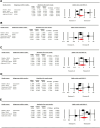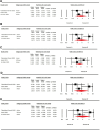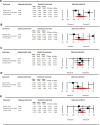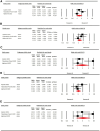Interleukin gene polymorphisms and alopecia areata: A systematic review and meta-analysis
- PMID: 38394507
- PMCID: PMC10883625
- DOI: 10.1097/MD.0000000000037300
Interleukin gene polymorphisms and alopecia areata: A systematic review and meta-analysis
Abstract
Background: Alopecia areata (AA) is an autoimmune disease which results in non-scarring hair loss on the scalp or any surface with hair. Several genetic polymorphisms of the interleukin genes have been linked with this disease but the results are inconsistent. This systematic review and meta-analysis were done to find the association between rs3118470, rs2275913, rs3212227, and rs10889677 of the IL2RA, IL17A, IL12B, and IL23R genes, respectively, of the interleukin family with alopecia areata.
Methods: A comprehensive search for relevant research articles was conducted in Pubmed, Google Scholar, and Embase databases. Our search yielded 8 relevant articles with 1940 cases and 1788 controls. The odds ratio with 95% confidence intervals was calculated using fixed effect and random effect models. Heterogeneity was determined using the Q-test and I2 test. Publication bias was determined and funnel plots were used to adjust the odds ratio.
Results: We found a significant risk effect for rs3118470 of the IL2RA gene with alopecia areata in the dominant model (CC + CT vs TT; OR = 1.54, 95% confidence interval = 1.05-2.26, P < .05, I2 = 69.03%) and homozygous model (CC vs TT; OR = 2.00, 95% confidence interval = 1.07-3.71, P < .05, I2 = 72.84%). For the other single nucleotide polymorphisms, we could not find any statistically significant association with the disease.
Conclusion: Our analysis showed that mutation of rs3118470 of IL2RA gene possesses a significant risk effect for alopecia areata. Future studies with larger sample sizes and ethnic backgrounds are warranted to confirm our findings.
Copyright © 2024 the Author(s). Published by Wolters Kluwer Health, Inc.
Conflict of interest statement
The authors have no funding and conflicts of interest to disclose.
Figures





References
-
- Zhou C, Li X, Wang C, et al. . Alopecia areata: an update on etiopathogenesis, diagnosis, and management. Clin Rev Allergy Immunol. 2021;61:403–23. - PubMed
-
- Nacional Reynosa P, Juárez-Rendón KJ, Rivera Sánchez G, et al. . Alopecia areata. Current situation and perspectives. Arch Argent Pediatr. 2017;115:404–11. - PubMed
-
- Simakou T, Butcher JP, Reid S, et al. . Alopecia areata: a multifactorial autoimmune condition. J Autoimmun. 2019;98:74–85. - PubMed
Publication types
MeSH terms
Substances
Supplementary concepts
LinkOut - more resources
Full Text Sources
Molecular Biology Databases

